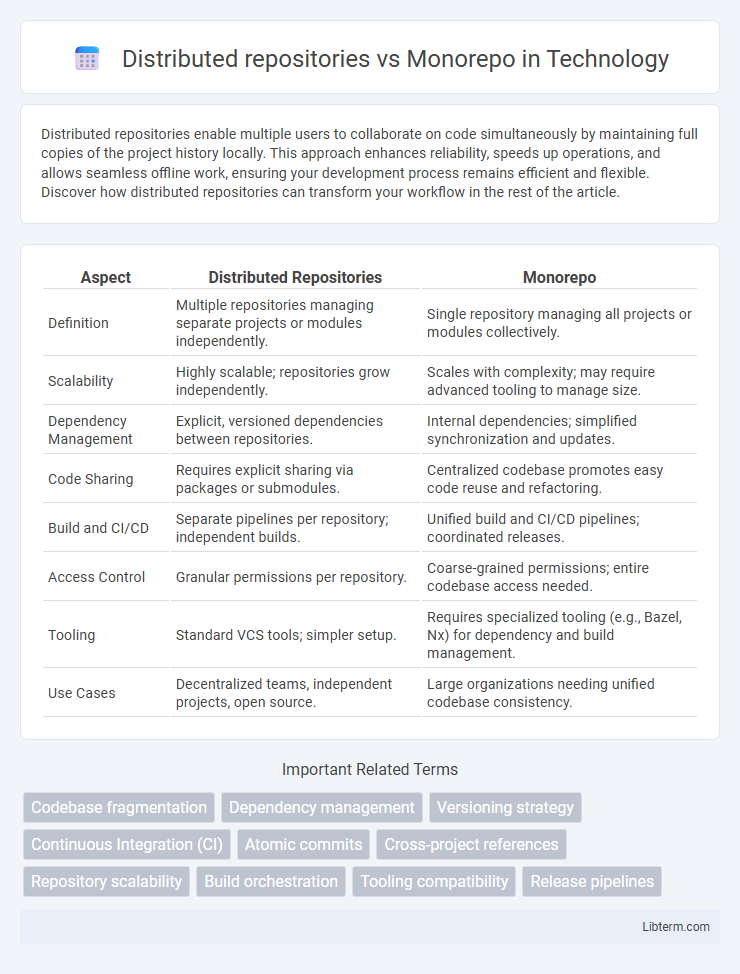Distributed repositories enable multiple users to collaborate on code simultaneously by maintaining full copies of the project history locally. This approach enhances reliability, speeds up operations, and allows seamless offline work, ensuring your development process remains efficient and flexible. Discover how distributed repositories can transform your workflow in the rest of the article.
Table of Comparison
| Aspect | Distributed Repositories | Monorepo |
|---|---|---|
| Definition | Multiple repositories managing separate projects or modules independently. | Single repository managing all projects or modules collectively. |
| Scalability | Highly scalable; repositories grow independently. | Scales with complexity; may require advanced tooling to manage size. |
| Dependency Management | Explicit, versioned dependencies between repositories. | Internal dependencies; simplified synchronization and updates. |
| Code Sharing | Requires explicit sharing via packages or submodules. | Centralized codebase promotes easy code reuse and refactoring. |
| Build and CI/CD | Separate pipelines per repository; independent builds. | Unified build and CI/CD pipelines; coordinated releases. |
| Access Control | Granular permissions per repository. | Coarse-grained permissions; entire codebase access needed. |
| Tooling | Standard VCS tools; simpler setup. | Requires specialized tooling (e.g., Bazel, Nx) for dependency and build management. |
| Use Cases | Decentralized teams, independent projects, open source. | Large organizations needing unified codebase consistency. |
Introduction to Repository Models
Distributed repositories store codebases independently, allowing teams to work on separate projects or components with isolated version control histories. Monorepos consolidate multiple projects into a single repository, enabling unified versioning, streamlined dependency management, and easier code sharing across teams. Choosing between distributed repositories and monorepos depends on factors such as project size, collaboration needs, and deployment workflows.
What is a Distributed Repository?
A distributed repository is a version control system architecture where each developer clones the entire repository, including its full history, allowing independent work without constant server communication. Git is a prime example of a distributed system, promoting flexibility, offline capabilities, and decentralized collaboration. This contrasts with centralized systems where the repository resides on a single server, limiting autonomy and scalability.
Understanding the Monorepo Approach
The monorepo approach organizes all codebases within a single repository, enabling seamless code sharing, consistent dependency management, and simplified refactoring across teams. Unlike distributed repositories that segregate projects into multiple repositories, monorepos offer unified version control and streamlined collaboration, reducing integration challenges. Large tech companies like Google and Facebook utilize monorepos to maintain massive, interconnected codebases, enhancing code visibility and accelerating development cycles.
Key Differences Between Distributed Repositories and Monorepo
Distributed repositories store code in multiple independent repositories, allowing teams to work on isolated components with greater autonomy and easier access control. Monorepo consolidates all project code into a single repository, enhancing code sharing, consistent dependency management, and streamlined refactoring. Key differences include scalability, collaboration complexity, version control strategies, and build processes, with distributed repositories favoring modularity and monorepos supporting unified development workflows.
Advantages of Distributed Repositories
Distributed repositories enable developers to work independently on isolated codebases, enhancing parallel development and minimizing merge conflicts. They facilitate greater flexibility by allowing teams to choose technology stacks and version control strategies tailored to individual projects. Improved scalability and security arise from isolating repositories, reducing the risk of a single point of failure or unauthorized access across the entire codebase.
Benefits of Monorepo Structures
Monorepo structures streamline code management by centralizing multiple projects into a single repository, enhancing collaboration and consistency across teams. They simplify dependency management and version control, reducing integration issues and improving build efficiency. This unified approach facilitates comprehensive code reuse, faster refactoring, and a holistic view of the entire codebase, accelerating development cycles and improving overall software quality.
Challenges and Drawbacks of Each Model
Distributed repositories often face challenges in maintaining code consistency and managing dependencies across multiple teams, leading to integration complexities and increased overhead for synchronization. Monorepos, while simplifying code sharing and coordination, can suffer from scalability issues, longer build times, and more complex version control due to the sheer volume of code maintained in a single repository. Both models require careful tooling and processes to address their inherent drawbacks, such as distributed repos needing efficient CI/CD pipelines and monorepos demanding robust build systems and modular architecture.
Use Cases: When to Choose Distributed vs. Monorepo
Distributed repositories fit projects with multiple independent teams working on distinct components, allowing isolated version control and tailored deployment cycles. Monorepos excel in environments requiring tight integration, consistent dependency management, and streamlined refactoring across shared codebases. Choosing depends on factors like team size, codebase modularity, and the need for synchronized releases or autonomy.
Best Practices for Migrating Between Repository Models
Migrating between distributed repositories and a monorepo requires careful planning to ensure code integrity and maintain developer productivity. Best practices include thorough codebase audits, establishing clear version control strategies, and implementing incremental migration with automated testing to catch integration issues early. Leveraging tools like commit history preservation and dependency graph analysis minimizes disruptions and supports seamless collaboration across teams during the transition.
Conclusion: Selecting the Right Repository Strategy
Choosing between distributed repositories and a monorepo depends on your team's size, project complexity, and collaboration needs. Distributed repositories offer modularity and flexibility for independent development, while monorepos enhance code sharing and simplify dependency management across multiple projects. Evaluating factors like build tools, version control scalability, and deployment workflows is crucial to determine the optimal repository strategy.
Distributed repositories Infographic

 libterm.com
libterm.com